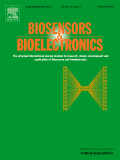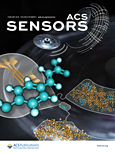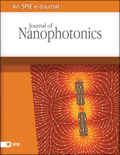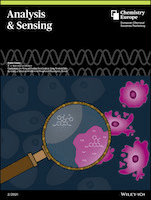
BIOSENSORS & BIOELECTRONICS
Scope & Guideline
Exploring the Intersection of Technology and Biology
Introduction
Aims and Scopes
- Biosensor Development:
Research on the design, fabrication, and optimization of various types of biosensors, including electrochemical, optical, and piezoelectric sensors, aimed at detecting biomolecules, pathogens, and environmental toxins. - Nanomaterials and Nanotechnology:
Exploration of nanostructured materials such as nanoparticles, metal-organic frameworks (MOFs), and carbon-based materials to enhance the sensitivity, selectivity, and functionality of biosensors. - Integration with Microfluidics:
Development of microfluidic devices that allow for the manipulation of small volumes of biofluids, enabling rapid and efficient analysis for applications in diagnostics and environmental monitoring. - Point-of-Care Testing:
Focus on creating portable, user-friendly biosensing devices that can provide immediate results in clinical settings, particularly for infectious diseases and chronic conditions. - Machine Learning and AI Applications:
Utilization of machine learning algorithms to improve data analysis, sensor performance, and the interpretation of complex biosensing data. - Environmental and Food Safety Monitoring:
Research aimed at developing biosensors for the detection of contaminants in food and environmental samples, ensuring safety and compliance with health regulations. - Clinical Diagnostics:
Investigation into the use of biosensors for the early detection of diseases, monitoring of biomarkers, and evaluation of therapeutic efficacy in clinical settings.
Trending and Emerging
- CRISPR-based Biosensing:
The integration of CRISPR technology for biosensing applications is gaining momentum, particularly for its ability to provide high specificity and sensitivity in detecting nucleic acids and proteins. - Wearable and Flexible Sensors:
There is a growing trend towards developing wearable biosensors that can continuously monitor health indicators, leveraging advancements in flexible materials and miniaturized electronics. - Machine Learning and Data-Driven Approaches:
The application of machine learning techniques for data analysis and sensor optimization is on the rise, enhancing the performance and accuracy of biosensing systems. - Environmental and Food Safety Applications:
Research focused on biosensors for real-time monitoring of environmental pollutants and food contaminants is increasingly prominent, reflecting societal concerns over health and safety. - Multi-Modal and Integrated Systems:
Emerging interest in systems that combine multiple sensing modalities (e.g., electrochemical, optical, and mechanical) to provide comprehensive data for diagnostics and monitoring. - 3D Printing and Advanced Fabrication Techniques:
Innovative approaches utilizing 3D printing and other advanced fabrication methods for creating complex biosensor architectures are becoming more prevalent. - Nanomaterials for Enhanced Sensitivity:
The use of advanced nanomaterials such as MXenes, metal-organic frameworks, and carbon nanomaterials for improving biosensor sensitivity and functionality is a rapidly growing area.
Declining or Waning
- Traditional Biosensing Techniques:
There has been a decline in publications focusing solely on traditional biosensing methods without incorporating novel materials or advanced technologies, as the field shifts towards more innovative and hybrid approaches. - Basic Research without Integration:
Research that does not emphasize integration with microfluidics or advanced data analysis techniques is becoming less frequent, as the field increasingly values systems that combine multiple functionalities. - Standalone Optical Methods:
Optical biosensing methods that do not leverage advances in nanotechnology or machine learning are witnessing a decrease in interest, as researchers pursue more complex and sensitive detection mechanisms. - Conventional Electrochemical Sensors:
While electrochemical sensors remain important, there is a noticeable shift towards more sophisticated designs that incorporate nanomaterials and multi-modal detection strategies, leading to fewer publications on basic electrochemical systems.
Similar Journals

SENSORS AND ACTUATORS B-CHEMICAL
Innovating the Future of Chemical Applications.SENSORS AND ACTUATORS B-CHEMICAL, published by ELSEVIER SCIENCE SA, is a premier scientific journal that occupies a vital niche in the field of materials science and engineering. With an impressive impact factor and ranking in the Q1 category across multiple disciplines, including Condensed Matter Physics, Electrical and Electronic Engineering, and Materials Chemistry, this journal is recognized as a leading source of innovative research and developments in sensor technologies and their chemical applications. The journal disseminates high-quality articles with a focus on the design, fabrication, and application of sensors and actuators, promoting valuable insights that cater to researchers, professionals, and students alike. As a testament to its scholarly significance, SENSORS AND ACTUATORS B-CHEMICAL remains pivotal for those seeking to advance their understanding of electronic, optical, and magnetic materials. The journal is accessible primarily through subscription, ensuring a wide reach to the academic community, and contributing significantly to the ongoing exploration and interdisciplinary collaboration in this dynamic field.

ACS Sensors
Advancing the frontiers of sensor technology.ACS Sensors, published by the American Chemical Society, is a premier journal focusing on the rapidly evolving field of sensors and sensing technologies. With an ISSN of 2379-3694, it has established itself as a key resource for researchers and professionals in bioengineering, fluid flow, instrumentation, and process chemistry. The journal holds a remarkable Q1 ranking across multiple categories, indicating its influential position within the academic community, with Scopus rankings placing it in the top echelons of its fields. Since its inception in 2016, ACS Sensors has provided high-quality, peer-reviewed research that drives innovation and application in sensor technology. The journal encourages submissions of original research articles, reviews, and technical notes that advance the understanding of sensing systems, showcasing novel methodologies and applications. While currently operating under a subscription model, the journal is committed to enhancing accessibility to cutting-edge discoveries. By fostering a collaborative environment for scientists and engineers, ACS Sensors is vital in bridging the gap between theory and practical applications, making it an essential read for those engaged in sensor development and application across various disciplines.

Journal of Nanophotonics
Bridging Science and Technology in NanophotonicsThe Journal of Nanophotonics, published by SPIE-SOC Photo-Optical Instrumentation Engineers, is an esteemed platform dedicated to advancing the field of nanotechnology through pioneering research in photonics. Since its inception in 2007, this journal has become instrumental in disseminating innovative findings and fostering collaborative discussions, especially in the domains of Condensed Matter Physics, Electronic, Optical and Magnetic Materials, and Nanoscience and Nanotechnology. Currently ranked within the Q3 category across these fields, it serves as a vital resource for academics, industry professionals, and students keen on exploring the multifaceted applications and implications of nanophotonic technologies. With its convergence set to continue until 2024, the journal offers a non-open-access model, ensuring rigorous peer-review standards and high-quality publications that contribute to the global body of knowledge.

Journal of Analysis and Testing
Advancing analytical excellence for a sustainable future.Journal of Analysis and Testing is a premier academic journal published by SPRINGER SINGAPORE PTE LTD, dedicated to advancing the fields of analytical and environmental chemistry. With ISSN 2096-241X and E-ISSN 2509-4696, the journal has established a significant presence since its inception in 2017, converging its focus until 2024. The journal's outstanding rankings in 2023, including Q1 quartile placements in Analytical Chemistry, Instrumentation, and Spectroscopy, underscore its pivotal role in disseminating high-quality research. Researchers can access cutting-edge studies that explore innovative testing methodologies, electrochemical analyses, and material evaluations, making it an essential resource for professionals and students alike. The Journal of Analysis and Testing not only celebrates advances in science and technology but also promotes interdisciplinary collaborations, ensuring widespread impact across analytical and environmental domains. As such, this journal plays a vital role in shaping the future of analytical practices and methodologies, positioning itself as a key conduit for knowledge exchange in the scholarly community.

BioChip Journal
Empowering Interdisciplinary Discoveries in Biochip ScienceBioChip Journal, published by the Korean Biochip Society (KBCS), is a renowned academic platform dedicated to advancing the fields of bioengineering, biomedical engineering, biotechnology, and electrical and electronic engineering. With its ISSN 1976-0280 and E-ISSN 2092-7843, this esteemed journal has established itself as a valuable resource for researchers, professionals, and students alike, providing them with cutting-edge research and insights since its inception in 2008. The journal has earned a commendable standing in the academic community, achieving Q2 ranking across key categories, thereby placing it amongst the top-tier publications. With its impressive Scopus rankings, including a top 10% position in Electrical and Electronic Engineering and a strong showing in both Biomedical Engineering and Biotechnology, BioChip Journal plays a vital role in disseminating innovative biochip technologies and applications. The journal continues to invite groundbreaking studies and reviews that promote the interdisciplinary collaboration essential for the future of biochip research, ultimately contributing to advancements in healthcare, diagnostics, and therapeutics.

Analysis & Sensing
Unveiling Insights Through Precision AnalysisAnalysis & Sensing is a prominent academic journal published by WILEY-V C H VERLAG GMBH, focusing on the critical fields of Analytical Chemistry, Electrochemistry, Spectroscopy, and Biochemistry. Established within the converged years from 2021 to 2024, the journal aims to advance knowledge in analytical and sensing techniques, providing a platform for high-quality research that reflects current trends and challenges in the scientific community. With a Scopus ranking that highlights its credibility—ranking 101st in Analytical Chemistry and 43rd in Electrochemistry—the journal caters to researchers, professionals, and students striving to enhance their understanding of analytical processes and methodologies. Although not open access, the quality of the articles published ensures a rigorous peer-review system, making it a vital resource for those who wish to remain at the forefront of research innovation in analytical sciences. Additionally, its global reach, indicated by its effective dissemination and relevance, underscores the journal's significance within the realm of chemical research.

BIOMEDICAL MICRODEVICES
Transforming Biomedical Engineering with Micro-InnovationsBIOMEDICAL MICRODEVICES is a leading journal published by Springer that focuses on the innovative field of microdevices within biomedical engineering. With an ISSN of 1387-2176 and an E-ISSN of 1572-8781, BIOMEDICAL MICRODEVICES offers a prestigious platform for researchers to disseminate their findings from 1998 to 2024, demonstrating a long-standing commitment to advancing knowledge in this critical area. The journal is recognized for its significant contributions, boasting a Q2 ranking in Biomedical Engineering and Nanoscience and Nanotechnology, and a Q3 rank in Molecular Biology. Renowned for its rigorous peer-review process, it is positioned within the top 30% of its field according to Scopus rankings, making it a valuable resource for researchers and practitioners alike. Though it operates under a subscription model, the emphasis on quality and relevance within its scope ensures that BIOMEDICAL MICRODEVICES remains a vital source of cutting-edge research that bridges engineering and biological systems, fostering innovation and collaboration in the pursuit of novel health solutions.

Plasmonics
Illuminating the Future of Biochemical TechnologiesPlasmonics, published by Springer, is a prestigious journal dedicated to advancing the field of plasmonics and its interdisciplinary applications, with a particular focus on biochemistry, biophysics, biotechnology, and nanoscience. Established in 2006, this peer-reviewed journal serves as a vital platform for researchers to disseminate groundbreaking findings and innovative methodologies related to the manipulation and application of surface plasmons for various technologies. Featuring an impressive Q3 ranking in critical scientific categories, including Biochemistry and Nanotechnology, Plasmonics is recognized for its contribution to enhancing the understanding of nanoscale phenomena and their relevance to contemporary research and development. While currently not an open-access publication, Plasmonics continues to play a key role in bridging academic inquiry and practical application, making it indispensable for professionals and students striving to stay at the forefront of this dynamic field.

OPTICS EXPRESS
Illuminating the Future of Optical ScienceOPTICS EXPRESS is a premier peer-reviewed journal published by the Optica Publishing Group, specializing in the rapidly evolving fields of Atomic and Molecular Physics and Optics. With an impressive Q1 ranking in its category and positioned in the 75th percentile among leading journals in Physics and Astronomy, OPTICS EXPRESS serves as a vital platform for disseminating innovative research findings. Since its inception in 1997 and transitioning to Open Access in 1998, the journal has ensured that groundbreaking scientific contributions are accessible to a global audience, fostering collaboration and advancement in optical science. Additionally, with annual publications converging from 1997 to 2024, this journal not only tracks the latest advancements but also shapes the future landscape of optics research. Whether you are a seasoned researcher, a dedicated professional, or a passionate student, OPTICS EXPRESS offers a wealth of knowledge and a commitment to excellence in the optics community.

International Journal of Electrochemical Science
Exploring the electrochemical landscape of tomorrow.International Journal of Electrochemical Science is a peer-reviewed journal dedicated to disseminating cutting-edge research in the field of electrochemistry. Published by Elsevier in Serbia, this journal serves as a vital platform for scientists and researchers to explore innovative electrochemical techniques, processes, and applications. With an ISSN of 1452-3981, it has been a respected source of scholarly articles since its inception in 2006 and continues to bridge the gap between theoretical advancements and practical implementations up until 2024. Notably, it holds a Q4 quartile ranking in the field of electrochemistry and ranks 41 out of 60 in the Scopus database, situating it within the 32nd percentile among its peers. The journal champions open academic discourse, contributing significantly to the advancement of knowledge in electrochemical sciences, making it an essential resource for researchers, professionals, and students alike who are striving towards new discoveries and innovations.